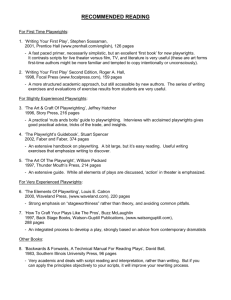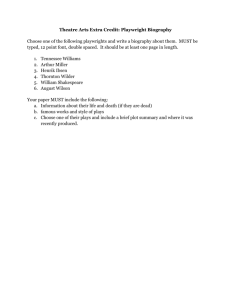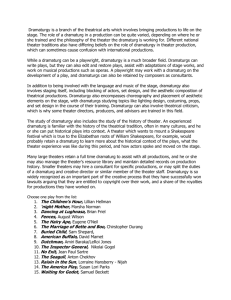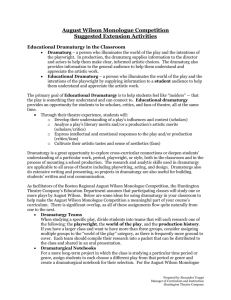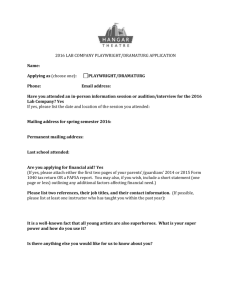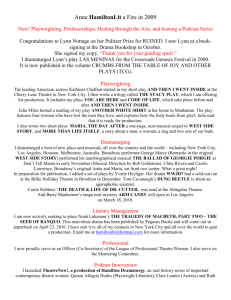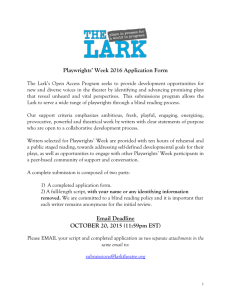– Playwriting and Dramaturgy Chapter 12
advertisement
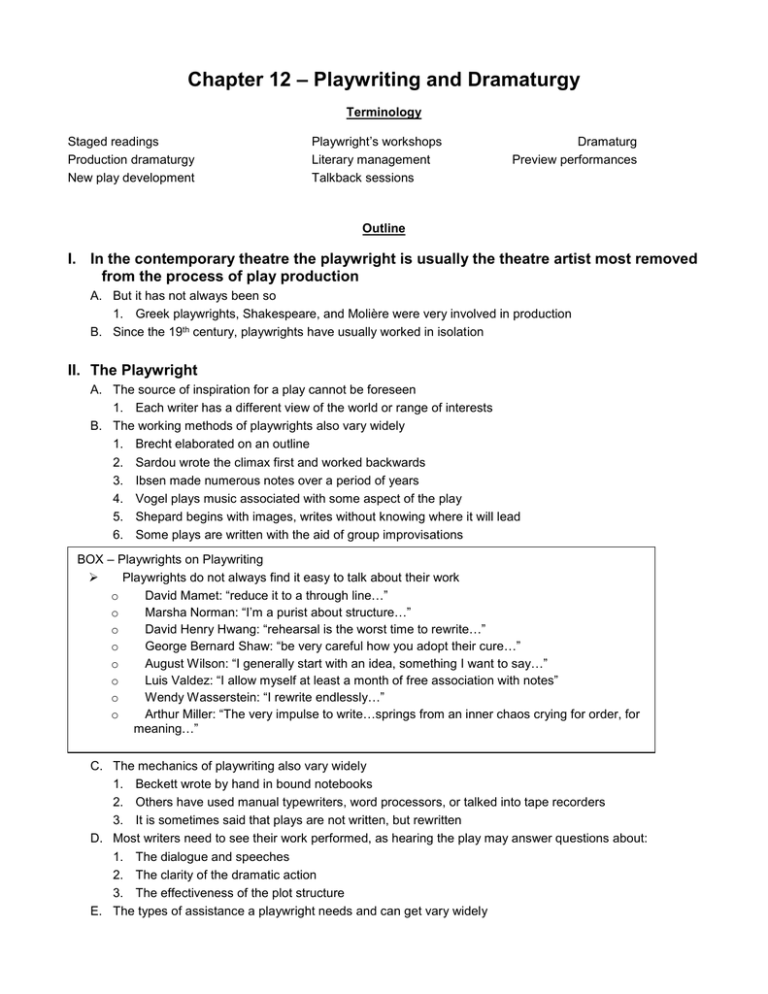
Chapter 12 – Playwriting and Dramaturgy Terminology Staged readings Production dramaturgy New play development Playwright’s workshops Literary management Talkback sessions Dramaturg Preview performances Outline I. In the contemporary theatre the playwright is usually the theatre artist most removed from the process of play production A. But it has not always been so 1. Greek playwrights, Shakespeare, and Molière were very involved in production B. Since the 19th century, playwrights have usually worked in isolation II. The Playwright A. The source of inspiration for a play cannot be foreseen 1. Each writer has a different view of the world or range of interests B. The working methods of playwrights also vary widely 1. Brecht elaborated on an outline 2. Sardou wrote the climax first and worked backwards 3. Ibsen made numerous notes over a period of years 4. Vogel plays music associated with some aspect of the play 5. Shepard begins with images, writes without knowing where it will lead 6. Some plays are written with the aid of group improvisations BOX – Playwrights on Playwriting Playwrights do not always find it easy to talk about their work o David Mamet: “reduce it to a through line…” o Marsha Norman: “I’m a purist about structure…” o David Henry Hwang: “rehearsal is the worst time to rewrite…” o George Bernard Shaw: “be very careful how you adopt their cure…” o August Wilson: “I generally start with an idea, something I want to say…” o Luis Valdez: “I allow myself at least a month of free association with notes” o Wendy Wasserstein: “I rewrite endlessly…” o Arthur Miller: “The very impulse to write…springs from an inner chaos crying for order, for meaning…” C. The mechanics of playwriting also vary widely 1. Beckett wrote by hand in bound notebooks 2. Others have used manual typewriters, word processors, or talked into tape recorders 3. It is sometimes said that plays are not written, but rewritten D. Most writers need to see their work performed, as hearing the play may answer questions about: 1. The dialogue and speeches 2. The clarity of the dramatic action 3. The effectiveness of the plot structure E. The types of assistance a playwright needs and can get vary widely 1. Reading the play aloud by one or more persons a. Gain feedback from those present b. One must assess the validity of others’ responses 2. Staged reading a. Audience response F. Some playwrights are members of playwright’s workshops 1. The Eugene O’Neill Theatre Center has assisted in the development of many new plays, including Ma Rainey’s Black Bottom G. Ultimately, full production is the playwright’s goal 1. The Actors Theatre of Louisville produces a festival of new plays each year 2. LaMama Experimental Theatre Club and the Manhattan Theatre Club also assist playwrights H. Unfortunately, the number of writers who obtain assistance is relatively small 1. Playwrights make many efforts to get their plays read, let alone produced 2. Despite all these efforts, some plays are never produced I. Most writers prefer to work through an agent 1. Agents choose to represent only those they consider potentially successful BOX – Playwrights Horizons Playwrights Horizon is dedicated to working with playwrights so that they can see their work performed, be allowed time to revise it, and see it performed again; sometimes the process takes several years. Each season they present at least six new plays or musicals, offer 20-25 readings of new plays, and award commissions for the early development of new works J. A producer may purchase an option on a script 1. The Dramatists Guild sets forth the typical provisions for contracts K. During rehearsals, many revisions may be made in a script 1. Some suggestions may come from a dramaturg 2. The director may make suggestions for revisions a. The director-playwright relationship can be a productive or destructive one 3. Producers also sometimes suggest revisions, usually in an attempt to increase income or decrease costs L. Scripts are often revised right up until opening night 1. Some playwrights continue to rework a script over many years III. The Dramaturg A. Many theatres now have a dramaturg on their staff., but the dramaturg is not a recent innovation 1. Gotthold Ephraim Lessing was the dramaturg for the Hamburg National Theater (Germany, 1767) a. Lessing’s dramaturgy established a precedent for later companies IV. Dramaturgy and Literary Management A. In the U.S., the scope of dramaturgy varies widely from one company to another, but there are two main types: 1. Literary management a. Finding, developing or shaping scripts b. Reading new scripts 2. Production Dramaturgy a. Working with directors on specific productions B. Literary management may also include new play development 1. Working with playwrights to realize their visions C. Current practices vary considerably from those typically used earlier 1. “Old” practices: a. Producers demand changes to increase box-office appeal b. Directors demand changes to enhance theatrical effectiveness c. Actors demand changes to enhance their roles 2. It is now more common for those working with playwrights to be most concerned with helping the writer achieve the full potential of the script D. But the old practices have not wholly disappeared, and not all playwrights are enthusiastic about “play development” 1. The playwright’s original impulse can become muddied by following well-meaning advice from others with different perspectives E. Literary managers are also usually involved in helping to select a company’s season of plays. They ask a three part question: 1. “Why this play for this audience at this time?” F. Literary managers or production dramaturgs may also be involved in the preparation of production scripts 1. Selecting or commissioning effective translations of non-English plays 2. Script adaptation to update outmoded dramatic or theatrical conventions V. Production Dramaturgy A. Production dramaturgy is concerned with specific productions 1. The dramaturg works closely with the director and designers 2. The dramaturg works closely with those concerned with publicity, programs and outreach 3. Dramaturgy can be considered the work of the director B. The production dramaturg helps the director make decisions by asking questions or supplying information crucial for clarifying the goals of the production 1. Research on the author’s life and writings 2. Research on the period or cultural environment 3. They also illuminate what prior critics or reviewers have written C. Dramaturgs usually attend rehearsal often and provide the director with feedback BOX – Dramaturgs on Dramaturgy Here are some attempts to describe dramaturgy and the role of the dramaturg: Mark Bly: “the dramaturg can be that artist who…helps the director and other artists to develop and shape the sociological, textual, directing, acting, and design values.” Art Borreca: “Dramaturgy contributes criticism and scholarship as well as emotional, moral and psychological support to the theatrical process.” Michael Lupu: “There is sufficient proof that bringing a play to life on stage can happen without the involvement of a dramaturg. For practical purposes, though, the production will fail or will not happen at all if dramaturgy is blatantly ignored.” Robert Brustein: “As the humanist in the woodpile, it is the dramaturg who must act as the conscience of the theatre, reminding it of its original promise, when it threatens to relax into facile, slack, and easy paths.” D. Dramaturgs often have some responsibility for educating the audience 1. They may supply materials about the play to those who do publicity 2. They may have some responsibility for the printed program 3. They may prepare auxiliary materials for outreach programs 4. They may be responsible for “talkback” sessions E. The dramaturg serves a critical and advisory function 1. It is therefore often difficult to isolate dramaturgical functions F. The work of the playwright and dramaturg often converges
